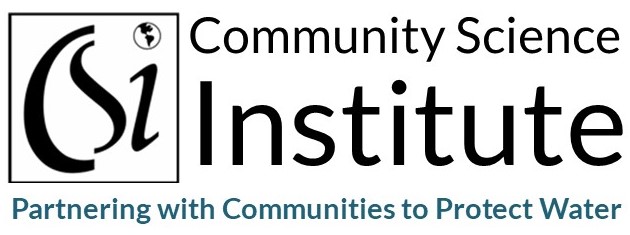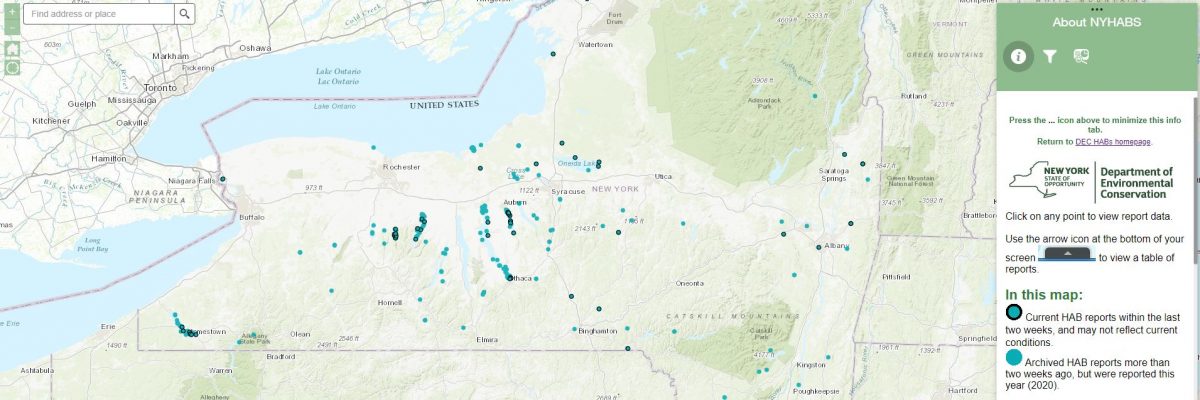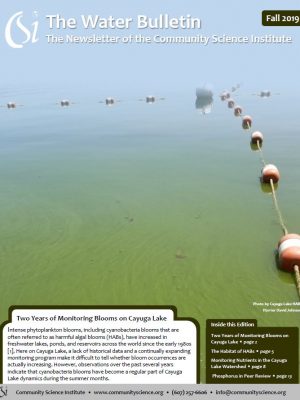2020 marks the third year that the Community Science Institute (CSI) has led the Cayuga Lake Harmful Algal Bloom (HABs) Monitoring Program in collaboration with the Cayuga Lake Watershed Network (CLWN) and Discover Cayuga Lake (DCL). The program is made possible by our dedicated volunteer HABs Harriers who monitor assigned lengths of shoreline for blooms each week from July to September – a big thank you to all of our amazing Harriers! The number of Harriers has continued to grow each year since the program started in 2017. In turn, this has allowed us to monitor more shoreline, which has improved our ability to help manage the risk these blooms present and further raise awareness about HABs throughout the communities around the Lake. Our ever growing network of volunteers is also helping us to collect even more data about HABs that will allow us to better understand the patterns of these blooms’ occurrences on Cayuga Lake.
Like many events this year, our HABs Harrier training was held online at the end of June. This year, the training included the announcement of an exciting new opportunity for volunteers of the program to get even more involved with monitoring HABs through CSI’s collaboration with Dr. Ruth Richardson. Her Civil and Environmental Engineering lab at Cornell is working to create a different way to predict toxin levels in HABs using light micrographs and DNA/RNA analysis. In addition to monitoring the shoreline weekly, some Harriers are now also helping out with this project by observing the blooms under a microscope and uploading pictures to be used for research at Dr. Richardson’s lab.
With 15 new volunteers participating in the spring training sessions, this year we now have over 90 harriers monitoring more than 51% of Cayuga’s shoreline. As of August 25th, 43 blooms have been collected on 21 different days, compared to 49 blooms by about the same time last year, and 17 by the same time in 2018. It is hard to tell whether the actual number of blooms increased from 2018-2019, or whether the number increased due to improved monitoring and increased public awareness.
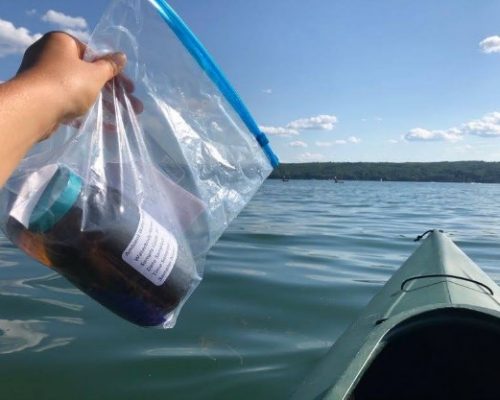
Harrier Maddy Czymmek with her kayak and HABs sampling kit monitoring her lakeshore zone for suspicious blooms.
This 2020 monitoring season, we have observed that in the northern half of the lake, more blooms have occurred earlier in the season, and with higher toxin concentrations than in past years. There have been 29 blooms that have exceeded the 4 ug/L safety limit for microcystin toxin in water set for contact recreation by the NYS Department of Health (NYSDOH) this season, and all except one have been located in the northern half of the lake. Meanwhile, 11 blooms have been collected from the southern half of the lake: 3 of them were not tested, 6 were under the 0.3 ug/L standard for drinking water safety, one between the drinking water and contact recreation safety limits, and one above the 4 ug/L safety limit.
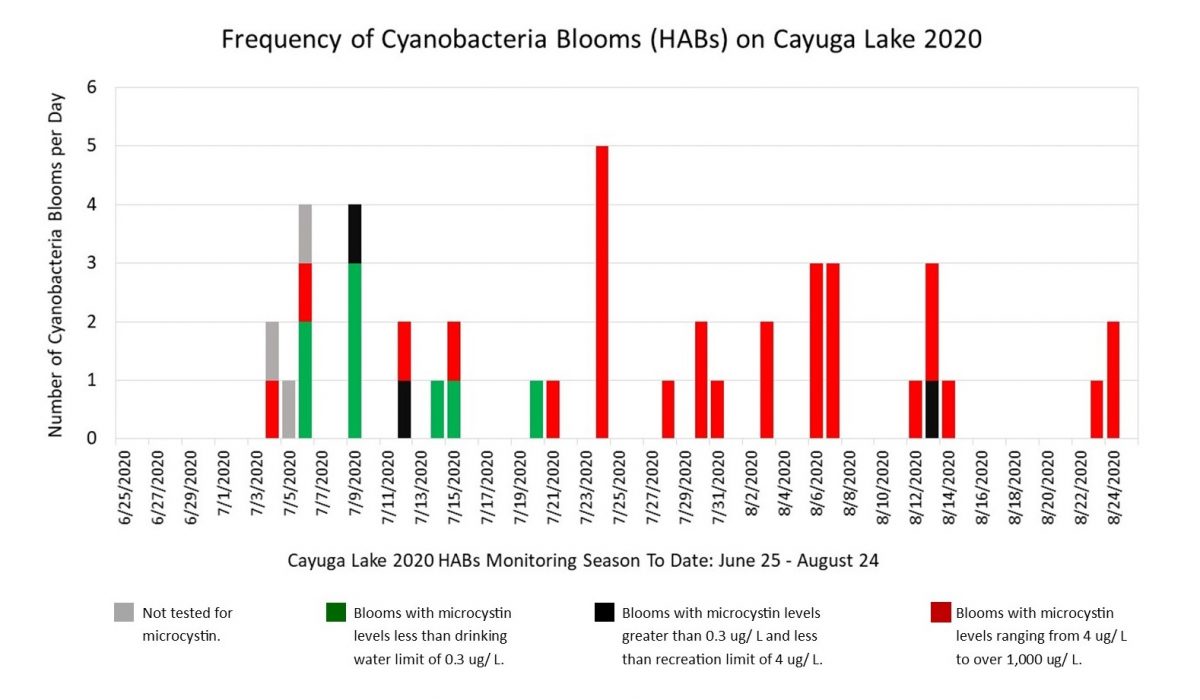
The 43 blooms that Harriers have reported on the Cayuga Lake shore this year have been confirmed by CSI’s certified water testing lab. CSI provides Harriers with a bottle and gloves to collect a sample safely if they see a bloom while walking or paddling their assigned shoreline. They also fill out a data sheet to record the location and time and take pictures of the bloom. CSI’s Outreach Coordinator, Nathaniel Launer, communicates closely with these volunteers to ensure the sample gets to the lab. Once at the lab, the process for confirming and analyzing a suspicious HAB begins with an examination of the bloom sample under the microscope to determine if cyanobacteria are present. This is done by CSI’s Biomonitoring Coordinator, Adrianna Hirtler. She determines which types of cyanobacteria are present in the bloom sample and the relative density for each type found: sparse, moderate, or dense. If cyanobacteria are present in the bloom sample, it is then tested for levels of chlorophyll and microcystin toxin. The amount of chlorophyll a helps determine the bloom density, while microcystin levels are compared to the safety guidelines set by the NYSDOH for safe drinking water levels and contact recreation. Determining the concentration of microcystin toxin present in HABs helps us better understand the risk these blooms present to lakeshore residents, visitors and people recreating on the lake. Our excellent lab analysts, Diana Beckenhaupt, Noah Mark and Alex Mints carry out these lab analyses, so that we can get the results out to the public as soon as possible.
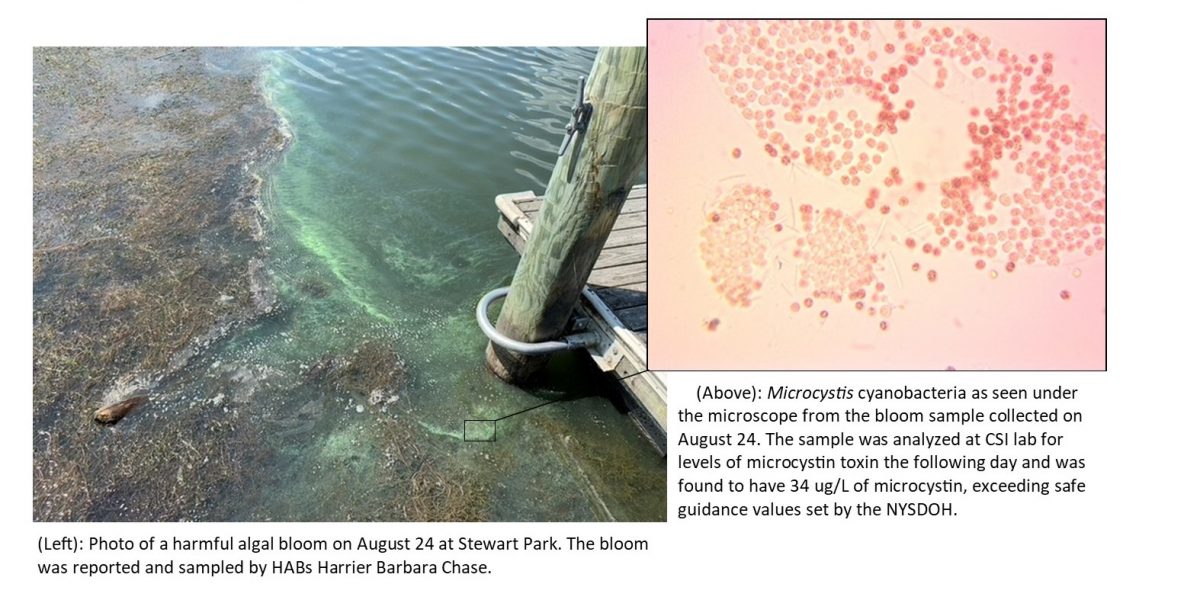
The photos and information provided by HABs Harrier Barbara Chase was reported on our Cayuga Lake HABs Reporting Page within hours. The results of lab analysis, including the determination of microcystin toxin concentration, was updated the next day.
If you’d like to stay informed about where blooms are occurring on Cayuga Lake, visit our Cayuga Lakes HABs Reporting Page on our website. We update our Cayuga Lake HABs Reporting Map within hours of when a bloom occurs. The lab analyses, including bloom toxin levels and bloom density, are updated within a week. The same information can be found in table-form by visiting the HABs Information and Results Table, also found on the reporting page.

If you would like to receive a weekly report summarizing bloom activity on Cayuga Lake, please contact the Cayuga Lake Watershed Network at programs@cayugalake.org or visit CLWN’s website to learn more.
If you see a HAB, avoid any contact with it and keeps kids and pets away!
Report the location, time, date, and two pictures to habshotline@gmail.com or online at Report a HAB
A trained HABs Harrier will respond and collect a sample if necessary.
The New York State Department of Environmental Conservation (NYSDEC) also has a map of HABs that have occurred statewide called NYHABs. CSI sends our results to the DEC weekly to be included on this statewide reporting map as well.
The NYHABs state-wide reporting map. HABs reports for Cayuga Lake are submitted by CSI to the NYSDEC weekly to be reported on NYHABs.
For more information about HABs, please visit CSI’s Harmful Algal Bloom Monitoring page or the NYSDEC HABs information page. If you have health concerns related to HABs exposure, please contact your physician and your local health department.
Support this important community program by making a donation today. Our lake-wide HABs monitoring program still depends on the support from people like you. Please, visit our online Cayuga Lake HABs Monitoring Program Fundraising Page and donate today.
Check out CSI’s interesting findings from the first two years of monitoring blooms on Cayuga Lake, published in our Fall 2019 Water Bulletin Newsletter.
Written by Community Science Programs Intern Madeline Czymmek
